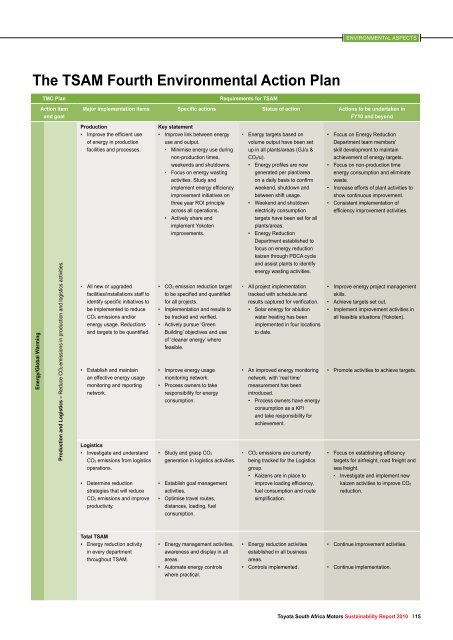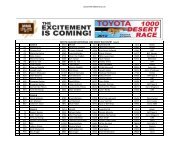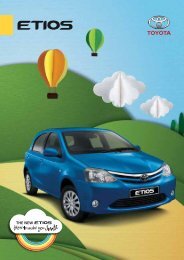to download PDF version - Toyota
to download PDF version - Toyota
to download PDF version - Toyota
You also want an ePaper? Increase the reach of your titles
YUMPU automatically turns print PDFs into web optimized ePapers that Google loves.
The TSAM Fourth Environmental Action Plan<br />
Energy/Global Warming<br />
TMC Plan Requirements for TSAM<br />
Action item<br />
and goal<br />
Production and Logistics – Reduce CO2 emissions in production and logistics activities.<br />
ENVIRONMENTAL ASPECTS<br />
Major implementation items Specific actions Status of action Actions <strong>to</strong> be undertaken in<br />
FY10 and beyond<br />
Production<br />
• Improve the efficient use<br />
of energy in production<br />
facilities and processes.<br />
• All new or upgraded<br />
facilities/installations staff <strong>to</strong><br />
identify specific initiatives <strong>to</strong><br />
be implemented <strong>to</strong> reduce<br />
CO2 emissions and/or<br />
energy usage. Reductions<br />
and targets <strong>to</strong> be quantified.<br />
• Establish and maintain<br />
an effective energy usage<br />
moni<strong>to</strong>ring and reporting<br />
network.<br />
Logistics<br />
• Investigate and understand<br />
CO2 emissions from logistics<br />
operations.<br />
• Determine reduction<br />
strategies that will reduce<br />
CO2 emissions and improve<br />
productivity.<br />
Total TSAM<br />
• Energy reduction activity<br />
in every department<br />
throughout TSAM.<br />
Key statement<br />
• Improve link between energy<br />
use and output.<br />
• Minimise energy use during<br />
non-production times,<br />
weekends and shutdowns.<br />
• Focus on energy wasting<br />
activities. Study and<br />
implement energy efficiency<br />
improvement initiatives on<br />
three year ROI principle<br />
across all operations.<br />
• Actively share and<br />
implement Yokoten<br />
improvements.<br />
• CO2<br />
emission reduction target<br />
<strong>to</strong> be specified and quantified<br />
for all projects.<br />
• Implementation and results <strong>to</strong><br />
be tracked and verified.<br />
• Actively pursue ‘Green<br />
Building’ objectives and use<br />
of ‘cleaner energy’ where<br />
feasible.<br />
• Improve energy usage<br />
moni<strong>to</strong>ring network.<br />
• Process owners <strong>to</strong> take<br />
responsibility for energy<br />
consumption.<br />
• Study and grasp CO2<br />
generation in logistics activities.<br />
• Establish goal management<br />
activities.<br />
• Optimise travel routes,<br />
distances, loading, fuel<br />
consumption.<br />
• Energy management activities,<br />
awareness and display in all<br />
areas.<br />
• Au<strong>to</strong>mate energy controls<br />
where practical.<br />
• Energy targets based on<br />
volume output have been set<br />
up in all plants/areas (GJ/u &<br />
CO2/u).<br />
• Energy profiles are now<br />
generated per plant/area<br />
on a daily basis <strong>to</strong> confirm<br />
weekend, shutdown and<br />
between shift usage.<br />
• Weekend and shutdown<br />
electricity consumption<br />
targets have been set for all<br />
plants/areas.<br />
• Energy Reduction<br />
Department established <strong>to</strong><br />
focus on energy reduction<br />
kaizen through PDCA cycle<br />
and assist plants <strong>to</strong> identify<br />
energy wasting activities.<br />
• All project implementation<br />
tracked with schedule and<br />
results captured for verification.<br />
• Solar energy for ablution<br />
water heating has been<br />
implemented in four locations<br />
<strong>to</strong> date.<br />
• An improved energy moni<strong>to</strong>ring<br />
network, with ‘real time’<br />
measurement has been<br />
introduced.<br />
• Process owners have energy<br />
consumption as a KPI<br />
and take responsibility for<br />
achievement.<br />
• CO2<br />
emissions are currently<br />
being tracked for the Logistics<br />
group.<br />
• Kaizens are in place <strong>to</strong><br />
improve loading efficiency,<br />
fuel consumption and route<br />
simplification.<br />
• Energy reduction activities<br />
established in all business<br />
areas.<br />
• Controls implemented.<br />
• Focus on Energy Reduction<br />
Department team members’<br />
skill development <strong>to</strong> maintain<br />
achievement of energy targets.<br />
• Focus on non-production time<br />
energy consumption and eliminate<br />
waste.<br />
• Increase efforts of plant activities <strong>to</strong><br />
show continuous improvement.<br />
• Consistent implementation of<br />
efficiency improvement activities.<br />
• Improve energy project management<br />
skills.<br />
• Achieve targets set out.<br />
• Implement improvement activities in<br />
all feasible situations (Yokoten).<br />
•<br />
Promote activities <strong>to</strong> achieve targets.<br />
• Focus on establishing efficiency<br />
targets for airfreight, road freight and<br />
sea freight.<br />
• Investigate and implement new<br />
kaizen activities <strong>to</strong> improve CO2<br />
reduction.<br />
•<br />
•<br />
Continue improvement activities.<br />
Continue implementation.<br />
<strong>Toyota</strong> South Africa Mo<strong>to</strong>rs Sustainability Report 2010 15





